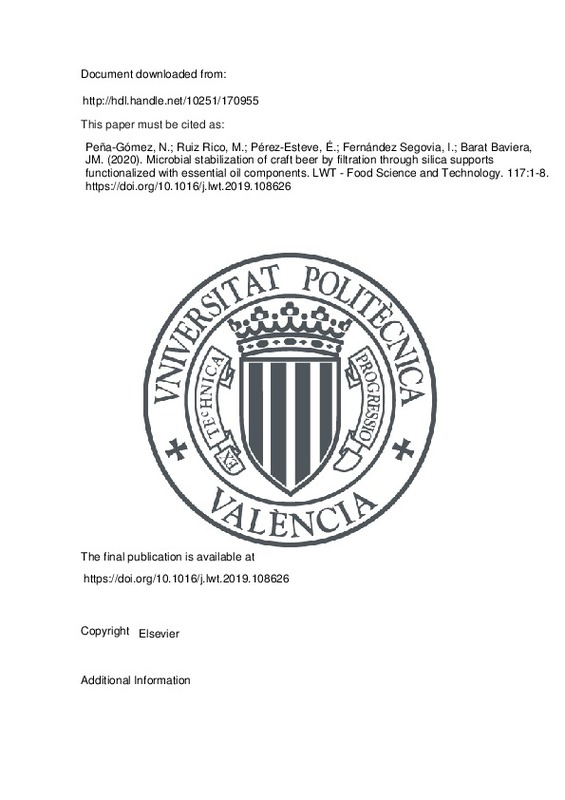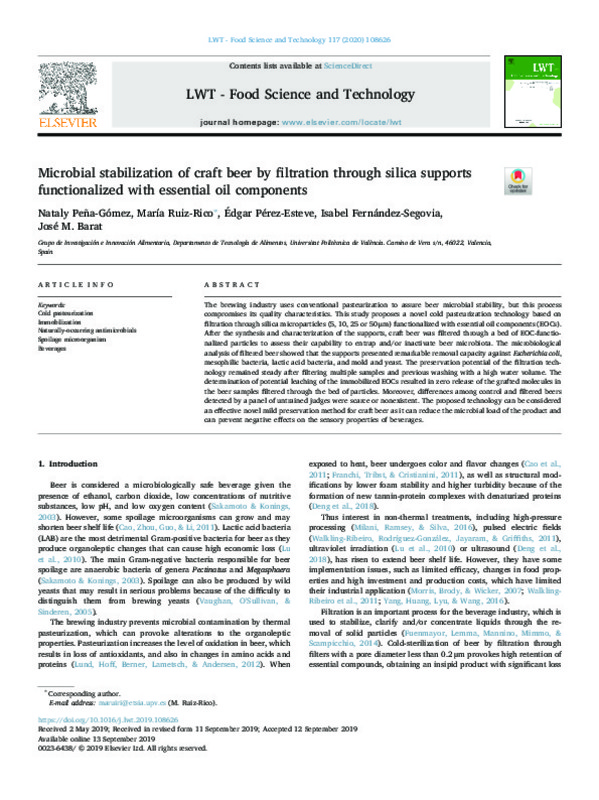JavaScript is disabled for your browser. Some features of this site may not work without it.
Buscar en RiuNet
Listar
Mi cuenta
Estadísticas
Ayuda RiuNet
Admin. UPV
Microbial stabilization of craft beer by filtration through silica supports functionalized with essential oil components
Mostrar el registro sencillo del ítem
Ficheros en el ítem
| dc.contributor.author | Peña-Gómez, Nataly
|
es_ES |
| dc.contributor.author | Ruiz Rico, María
|
es_ES |
| dc.contributor.author | Pérez-Esteve, Édgar
|
es_ES |
| dc.contributor.author | Fernández Segovia, Isabel
|
es_ES |
| dc.contributor.author | Barat Baviera, José Manuel
|
es_ES |
| dc.date.accessioned | 2021-07-30T03:30:58Z | |
| dc.date.available | 2021-07-30T03:30:58Z | |
| dc.date.issued | 2020-01 | es_ES |
| dc.identifier.issn | 0023-6438 | es_ES |
| dc.identifier.uri | http://hdl.handle.net/10251/170955 | |
| dc.description.abstract | [EN] The brewing industry uses conventional pasteurization to assure beer microbial stability, but this process compromises its quality characteristics. This study proposes a novel cold pasteurization technology based on filtration through silica microparticles (5, 10, 25 or 50 mu m) functionalized with essential oil components (EOCs). After the synthesis and characterization of the supports, craft beer was filtered through a bed of EOC-functionalized particles to assess their capability to entrap and/or inactivate beer microbiota. The microbiological analysis of filtered beer showed that the supports presented remarkable removal capacity against Escherichia coli, mesophilic bacteria, lactic acid bacteria, and mold and yeast. The preservation potential of the filtration technology remained steady after filtering multiple samples and previous washing with a high water volume. The determination of potential leaching of the immobilized EOCs resulted in zero release of the grafted molecules in the beer samples filtered through the bed of particles. Moreover, differences among control and filtered beers detected by a panel of untrained judges were scarce or nonexistent. The proposed technology can be considered an effective novel mild preservation method for craft beer as it can reduce the microbial load of the product and can prevent negative effects on the sensory properties of beverages. | es_ES |
| dc.description.sponsorship | Authors gratefully acknowledge the financial support from the Ministerio de Ciencia, Innovacion y Universidades, the Agencia Estatal de Investigacion and FEDER-EU (Project RTI2018-101599-B-C21). N.P.G. is grateful to Generalitat Valencia for her grant. The authors also thank the Electron Microscopy Service at the UPV for support. | es_ES |
| dc.language | Inglés | es_ES |
| dc.publisher | Elsevier | es_ES |
| dc.relation.ispartof | LWT - Food Science and Technology | es_ES |
| dc.rights | Reconocimiento - No comercial - Sin obra derivada (by-nc-nd) | es_ES |
| dc.subject | Cold pasteurization | es_ES |
| dc.subject | Immobilization | es_ES |
| dc.subject | Naturally-occurring | es_ES |
| dc.subject | Antimicrobials | es_ES |
| dc.subject | Spoilage microorganism | es_ES |
| dc.subject | Beverages. | es_ES |
| dc.subject.classification | TECNOLOGIA DE ALIMENTOS | es_ES |
| dc.title | Microbial stabilization of craft beer by filtration through silica supports functionalized with essential oil components | es_ES |
| dc.type | Artículo | es_ES |
| dc.identifier.doi | 10.1016/j.lwt.2019.108626 | es_ES |
| dc.relation.projectID | info:eu-repo/grantAgreement/AEI/Plan Estatal de Investigación Científica y Técnica y de Innovación 2017-2020/RTI2018-101599-B-C21/ES/DESARROLLO Y APLICACION DE SISTEMAS ANTIMICROBIANOS PARA LA INDUSTRIA ALIMENTARIA BASADOS EN SUPERFICIES FUNCIONALIZADAS Y SISTEMAS DE LIBERACION CONTROLADA/ | es_ES |
| dc.relation.projectID | info:eu-repo/grantAgreement/MINECO//AGL2015-70235-C2-1-R/ES/SISTEMAS HIBRIDOS BASADOS EN SOPORTES BIOCOMPATIBLES PARA EL DESARROLLO DE ANTIMICROBIANOS A PARTIR DE SUSTANCIAS NATURALES Y LIBERACION CONTROLADA DE COMPUESTOS ALIMENTARIOS/ | es_ES |
| dc.rights.accessRights | Abierto | es_ES |
| dc.contributor.affiliation | Universitat Politècnica de València. Departamento de Tecnología de Alimentos - Departament de Tecnologia d'Aliments | es_ES |
| dc.description.bibliographicCitation | Peña-Gómez, N.; Ruiz Rico, M.; Pérez-Esteve, É.; Fernández Segovia, I.; Barat Baviera, JM. (2020). Microbial stabilization of craft beer by filtration through silica supports functionalized with essential oil components. LWT - Food Science and Technology. 117:1-8. https://doi.org/10.1016/j.lwt.2019.108626 | es_ES |
| dc.description.accrualMethod | S | es_ES |
| dc.relation.publisherversion | https://doi.org/10.1016/j.lwt.2019.108626 | es_ES |
| dc.description.upvformatpinicio | 1 | es_ES |
| dc.description.upvformatpfin | 8 | es_ES |
| dc.type.version | info:eu-repo/semantics/publishedVersion | es_ES |
| dc.description.volume | 117 | es_ES |
| dc.relation.pasarela | S\387098 | es_ES |
| dc.contributor.funder | Generalitat Valenciana | es_ES |
| dc.contributor.funder | Ministerio de Economía y Competitividad | es_ES |
| dc.contributor.funder | Agencia Estatal de Investigación | es_ES |
| dc.contributor.funder | European Regional Development Fund | es_ES |
| dc.contributor.funder | Ministerio de Ciencia, Innovación y Universidades | es_ES |
| dc.description.references | Burt, S. (2004). Essential oils: their antibacterial properties and potential applications in foods—a review. International Journal of Food Microbiology, 94(3), 223-253. doi:10.1016/j.ijfoodmicro.2004.03.022 | es_ES |
| dc.description.references | Cao, L., Zhou, G., Guo, P., & Li, Y. (2011). Influence of Pasteurising Intensity on Beer Flavour Stability. Journal of the Institute of Brewing, 117(4), 587-592. doi:10.1002/j.2050-0416.2011.tb00508.x | es_ES |
| dc.description.references | Chavan, P. S., & Tupe, S. G. (2014). Antifungal activity and mechanism of action of carvacrol and thymol against vineyard and wine spoilage yeasts. Food Control, 46, 115-120. doi:10.1016/j.foodcont.2014.05.007 | es_ES |
| dc.description.references | Deng, Y., Bi, H., Yin, H., Yu, J., Dong, J., Yang, M., & Ma, Y. (2018). Influence of ultrasound assisted thermal processing on the physicochemical and sensorial properties of beer. Ultrasonics Sonochemistry, 40, 166-173. doi:10.1016/j.ultsonch.2017.07.017 | es_ES |
| dc.description.references | Devi, R., Alemayehu, E., Singh, V., Kumar, A., & Mengistie, E. (2008). Removal of fluoride, arsenic and coliform bacteria by modified homemade filter media from drinking water. Bioresource Technology, 99(7), 2269-2274. doi:10.1016/j.biortech.2007.05.002 | es_ES |
| dc.description.references | Fillaudeau, L., & Carrère, H. (2002). Yeast cells, beer composition and mean pore diameter impacts on fouling and retention during cross-flow filtration of beer with ceramic membranes. Journal of Membrane Science, 196(1), 39-57. doi:10.1016/s0376-7388(01)00568-3 | es_ES |
| dc.description.references | Franchi, M. A., Tribst, A. A. L., & Cristianini, M. (2011). Effects of High Pressure Homogenization on Beer Quality Attributes. Journal of the Institute of Brewing, 117(2), 195-198. doi:10.1002/j.2050-0416.2011.tb00460.x | es_ES |
| dc.description.references | Fuenmayor, C. A., Lemma, S. M., Mannino, S., Mimmo, T., & Scampicchio, M. (2014). Filtration of apple juice by nylon nanofibrous membranes. Journal of Food Engineering, 122, 110-116. doi:10.1016/j.jfoodeng.2013.08.038 | es_ES |
| dc.description.references | Gialleli, A.-I., Bekatorou, A., Kanellaki, M., Nigam, P., & Koutinas, A. A. (2016). Apple juice preservation through microbial adsorption by nano/micro-tubular cellulose. Innovative Food Science & Emerging Technologies, 33, 416-421. doi:10.1016/j.ifset.2015.11.006 | es_ES |
| dc.description.references | Gil, G., del Mónaco, S., Cerrutti, P., & Galvagno, M. (2004). Selective antimicrobial activity of chitosan on beer spoilage bacteria and brewing yeasts. Biotechnology Letters, 26(7), 569-574. doi:10.1023/b:bile.0000021957.37426.9b | es_ES |
| dc.description.references | Holley, R. A., & Patel, D. (2005). Improvement in shelf-life and safety of perishable foods by plant essential oils and smoke antimicrobials. Food Microbiology, 22(4), 273-292. doi:10.1016/j.fm.2004.08.006 | es_ES |
| dc.description.references | Hyldgaard, M., Mygind, T., & Meyer, R. L. (2012). Essential Oils in Food Preservation: Mode of Action, Synergies, and Interactions with Food Matrix Components. Frontiers in Microbiology, 3. doi:10.3389/fmicb.2012.00012 | es_ES |
| dc.description.references | Lu, G., Li, C., Liu, P., Cui, H., Yao, Y., & Zhang, Q. (2010). UV inactivation of microorganisms in beer by a novel thin-film apparatus. Food Control, 21(10), 1312-1317. doi:10.1016/j.foodcont.2010.03.007 | es_ES |
| dc.description.references | Lund, M. N., Hoff, S., Berner, T. S., Lametsch, R., & Andersen, M. L. (2012). Effect of Pasteurization on the Protein Composition and Oxidative Stability of Beer during Storage. Journal of Agricultural and Food Chemistry, 60(50), 12362-12370. doi:10.1021/jf303044a | es_ES |
| dc.description.references | Milani, E. A., Ramsey, J. G., & Silva, F. V. M. (2016). High pressure processing and thermosonication of beer: Comparing the energy requirements and Saccharomyces cerevisiae ascospores inactivation with thermal processing and modeling. Journal of Food Engineering, 181, 35-41. doi:10.1016/j.jfoodeng.2016.02.023 | es_ES |
| dc.description.references | Morris, C., Brody, A. L., & Wicker, L. (2007). Non-thermal food processing/preservation technologies: a review with packaging implications. Packaging Technology and Science, 20(4), 275-286. doi:10.1002/pts.789 | es_ES |
| dc.description.references | Ribes, S., Ruiz-Rico, M., Pérez-Esteve, É., Fuentes, A., Talens, P., Martínez-Máñez, R., & Barat, J. M. (2017). Eugenol and thymol immobilised on mesoporous silica-based material as an innovative antifungal system: Application in strawberry jam. Food Control, 81, 181-188. doi:10.1016/j.foodcont.2017.06.006 | es_ES |
| dc.description.references | Rota, M. C., Herrera, A., Martínez, R. M., Sotomayor, J. A., & Jordán, M. J. (2008). Antimicrobial activity and chemical composition of Thymus vulgaris, Thymus zygis and Thymus hyemalis essential oils. Food Control, 19(7), 681-687. doi:10.1016/j.foodcont.2007.07.007 | es_ES |
| dc.description.references | Ruiz-Rico, M., Pérez-Esteve, É., Bernardos, A., Sancenón, F., Martínez-Máñez, R., Marcos, M. D., & Barat, J. M. (2017). Enhanced antimicrobial activity of essential oil components immobilized on silica particles. Food Chemistry, 233, 228-236. doi:10.1016/j.foodchem.2017.04.118 | es_ES |
| dc.description.references | Sakamoto, K., & Konings, W. N. (2003). Beer spoilage bacteria and hop resistance. International Journal of Food Microbiology, 89(2-3), 105-124. doi:10.1016/s0168-1605(03)00153-3 | es_ES |
| dc.description.references | Valente, I. M., Santos, C. M., Moreira, M. M., & Rodrigues, J. A. (2013). New application of the QuEChERS methodology for the determination of volatile phenols in beverages by liquid chromatography. Journal of Chromatography A, 1271(1), 27-32. doi:10.1016/j.chroma.2012.11.026 | es_ES |
| dc.description.references | Vaughan, A., O’Sullivan, T., & Sinderen, D. (2005). Enhancing the Microbiological Stability of Malt and Beer - A Review. Journal of the Institute of Brewing, 111(4), 355-371. doi:10.1002/j.2050-0416.2005.tb00221.x | es_ES |
| dc.description.references | Walkling-Ribeiro, M., Rodríguez-González, O., Jayaram, S. H., & Griffiths, M. W. (2011). Processing temperature, alcohol and carbonation levels and their impact on pulsed electric fields (PEF) mitigation of selected characteristic microorganisms in beer. Food Research International, 44(8), 2524-2533. doi:10.1016/j.foodres.2011.01.046 | es_ES |
| dc.description.references | Yang, N., Huang, K., Lyu, C., & Wang, J. (2016). Pulsed electric field technology in the manufacturing processes of wine, beer, and rice wine: A review. Food Control, 61, 28-38. doi:10.1016/j.foodcont.2015.09.022 | es_ES |









